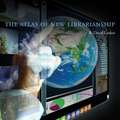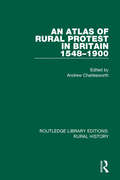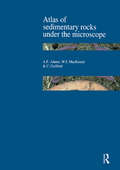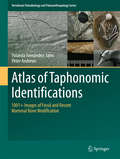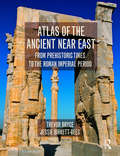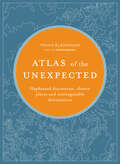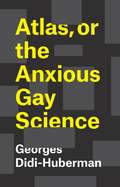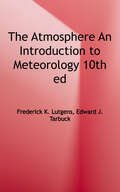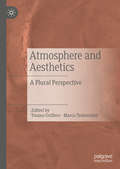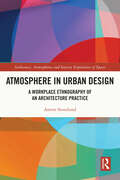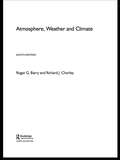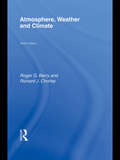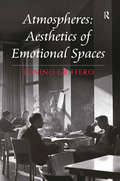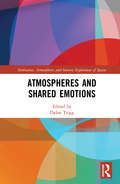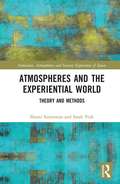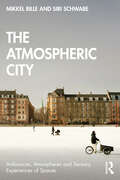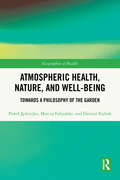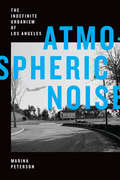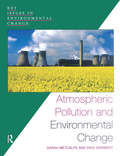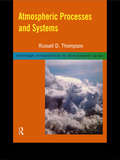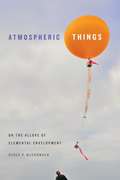- Table View
- List View
The Atlas Of New Librarianship
by R. David LankesLibraries have existed for millennia, but today the library field is searching for solid footing in an increasingly fragmented (and increasingly digital) information environment. What is librarianship when it is unmoored from cataloging, books, buildings, and committees? In The Atlas of New Librarianship, R. David Lankes offers a guide to this new landscape for practitioners. He describes a new librarianship based not on books and artifacts but on knowledge and learning; and he suggests a new mission for librarians: to improve society through facilitating knowledge creation in their communities. The vision for a new librarianship must go beyond finding library-related uses for information technology and the Internet; it must provide a durable foundation for the field. Lankes recasts librarianship and library practice using the fundamental concept that knowledge is created though conversation. New librarians approach their work as facilitators of conversation; they seek to enrich, capture, store, and disseminate the conversations of their communities. To help librarians navigate this new terrain, Lankes offers a map, a visual representation of the field that can guide explorations of it; more than 140 Agreements, statements about librarianship that range from relevant theories to examples of practice; and Threads, arrangements of Agreements to explain key ideas, covering such topics as conceptual foundations and skills and values. Agreement Supplements at the end of the book offer expanded discussions. Although it touches on theory as well as practice, the Atlas is meant to be a tool: textbook, conversation guide, platform for social networking, and call to action. Copublished with the Association of College & Research Libraries.
An Atlas of Poverty in America: One Nation, Pulling Apart 1960–2003
by Amy GlasmeierPersistant poverty has long been one of America's most pressing and intractable problems. According to some estimates, by 2003, almost twenty-five percent of the America's countries had per-capita incomes below one half the national average, high unemployment, low labour force participation rates, and a high dependency on government transfer payments - all measures of economic distress. An Atlas of Poverty in America shows how and where America's regional development patterns have become more uneven, and graphically illustrates the increasing number of communities falling behind the national economic average. Readers will be able to use this Atlas to see how major events and trends have impacted the scope and extent of American poverty in the past half-century:economic globalization, the rise of the sunbelt, decline of the welfare state, and the civil rights movement. Also includes 195 colour maps.
An Atlas of Rural Protest in Britain 1548-1900 (Routledge Library Editions: Rural History #2)
by Andrew CharlesworthThe outbreaks and collective violence arising from the tensions existing within society have long been themes in the study of British social history. This book, first published in 1983, attempts to survey the whole range of these rural riots, to compare and contrast them, and to draw general conclusions. Seventy-five maps are included in this volume, each with an accompanying commentary written by an authority on the particular subject. Taken together, the maps show how the distribution of protest changed over time, how particular forms of protest – riots connected with land, with food and with labour – altered as Britain developed from a predominantly feudal to a prominently capitalist society. This title will be of interest to students of history.
Atlas of Sedimentary Rocks Under the Microscope
by A. E. Adams W. S. Mackenzie C. GuilfordProvides a very clear guide to sedimentary rock types as seen under the microscope supported by practical aspects of slide preparation.
Atlas of Taphonomic Identifications: 1001+ Images of Fossil and Recent Mammal Bone Modification (Vertebrate Paleobiology and Paleoanthropology #0)
by Peter Andrews Yolanda Fernández-JalvoThe aim of the atlas is to provide images of taphonomic modifications, making it as comprehensive as possible with evidence presently available. This volume is intended both as a field guide for identifying taphonomic modifications in the field, and for use in the laboratory when collections of fossils are being analyzed. Images in the book are a combination of scanning electron micrographs, regular photographs, cross-sections of bones and line drawings and graphs. By providing good quality illustrations of taphonomic modifications, with links between similar types of modification, the atlas provides a reference source for identifying the agents responsible for the modifications, the processes by which they were formed, and the potential bias introduced by the processes. The authors also aim to emphasize on the directions they consider taphonomic studies should be headed. Firstly, we should seek to quantify the degree of bias introduced into a fossil fauna and to take account of this bias before interpreting the palaeoecology of the fossil site. Secondly, we should recognize that taphonomic modifications increase the information encoded in fossils by identifying perimortem and postmortem context s. This provides a more dynamic and realistic view of the past.
Atlas of the Ancient Near East: From Prehistoric Times to the Roman Imperial Period
by Trevor Bryce Jessie Birkett-ReesThis atlas provides students and scholars with a broad range of information on the development of the Ancient Near East from prehistoric times through the beginning of written records in the Near East (c. 3000 BC) to the late Roman Empire and the rise of Islam. The geographical coverage of the Atlas extends from the Aegean coast of Anatolia in the west through Iran and Afghanistan to the east, and from the Black and Caspian Seas in the north to Arabia and the Persian Gulf and Indian Ocean in the south. The Atlas of the Ancient Near East includes a wide-ranging overview of the civilizations and kingdoms discussed, written in a lively and engaging style, which considers not only political and military issues but also introduces the reader to social and cultural topics such as trade, religion, how people were educated and entertained, and much more. With a comprehensive series of detailed maps, supported by the authors’ commentary and illustrations of major sites and key artifacts, this title is an invaluable resource for students who wish to understand the fascinating cultures of the Ancient Near East.
Atlas of the Rock-Forming Minerals in Thin Section
by W. S. Mackenzie C. Guilford'Hurray for Mackenzie and Guilford for at last we have a pictorial guide to the rock-forming minerals! . . . such feasts of colour in mineralogy books are rare . . . an admirable guide'New Scientist
Atlas of the Unexpected: Haphazard Discoveries, Chance Places and Unimaginable Destinations (Unexpected Atlases Ser.)
by Travis ElboroughA journey to forty-five unexpected destinations near and far, with quirky histories, beautiful maps, and evocative photography: “First-class armchair travel.” —South China Morning PostA New Statesman Best Book of the YearTake an armchair voyage to places both infamous and unknown that have, often by chance or by haphazard means, been destinations of discovery that shaped our world. Set foot on the aptly named Just Enough Room Island. Chart the royal romance that led shipwrecked lovers to discover the purple rock of Madeira. Learn about the surprising origins of Vaseline. Follow in the footsteps of a stray goat who led its keeper to uncover lost ancient biblical scrolls. These are the world’s most wondrous, improbable, and—most of all—unexpected places, presented by a cultural historian and winner of an Edward Stanford Travel Writing Award.“Elborough writes about a wide range of subjects with originality, learning and charm. Atlas of the Unexpected . . . is seductively beautiful: an inspiring, dream-inducing guide.” —New StatesmanPraise for the Unexpected Atlas series“Engrossing.” —The Observer“Understatedly expressive.” —The New York Times“A delightful compendium.” —The Daily Telegraph
An Atlas of World Affairs
by Joshua Comenetz Andrew BoydThe economic, social and environmental systems of the world remain in turmoil. Recent years have seen possibly irrevocable change in the politics of Europe, Asia, Africa and Latin America. This entirely revised and updated 11th edition describes the people, factions, and events that have shaped the modern world from the Second World War to the present day. International issues and conflicts are placed in their geographical contexts through the integration of over one hundred maps. The political context provided for current events will be invaluable to all those uncertain about the changing map of Europe and Africa, conflicts in the Middle East, and the appearances in the headlines and on our television screens by al-Qaeda, Chechnya, the Taliban, Mercosur, Somaliland, Kosovo, AIDS, OPEC, and Schengenland. Critical new issues are covered including the war on terrorism, nuclear proliferation, European Union expansion, and the pressing environmental concerns faced by many sovereign states. This edition provides guidance through all these recent changes (and many more). This book offers up-to-date coverage of all regions in great detail. It contains an objective and concise explanation of current events, combining maps with their geopolitical background. It provides a clear context for events in the news, covering the Middle East, Korea, China, the European Union, east Africa, and every other part of the world. Revised and in print since 1957, An Atlas of World Affairs continues to provide a valuable guide for the student, teacher, journalist and all those interested in current affairs and post-war political history.
Atlas, or the Anxious Gay Science: How To Carry The World On One's Back?
by Georges Didi-Huberman Shane B. LillisAby Warburg’s Mnemosyne Atlas (1925–1929) is a prescient work of mixed media assemblage, made up of hundreds of images culled from antiquity to the Renaissance and arranged into startling juxtapositions. Warburg’s allusive atlas sought to illuminate the pains of his final years, after he had suffered a breakdown and been institutionalized. It continues to influence contemporary artists today, including Gerhard Richter and Mark Dion. In this illustrated exploration of Warburg and his great work, Georges Didi-Huberman leaps from Mnemosyne Atlas into a set of musings on the relation between suffering and knowledge in Western thought, and on the creative results of associative thinking. Deploying writing that delights in dramatic jump cuts reminiscent of Warburg’s idiosyncratic juxtapositions, and drawing on a set of sources that ranges from ancient Babylon to Walter Benjamin, Atlas, or the Anxious Gay Science is rich in Didi-Huberman’s trademark combination of elan and insight.
The Atmosphere: An Introduction to Meteorology
by Frederick K. Lutgens Edward J. TarbuckUsing everyday, easy-to-grasp examples to reinforce basic concepts, this highly regarded handbook remains the standard introduction to meteorology and the atmosphere – components, problems, and applications. Includes the most up-to-date coverage of topics such as: ozone depletion; the ultraviolet index; temperature; dew point temperature and orographic effects; wildfires and weather; thunderstorms and lightning; the record-breaking Florida hurricane season; effects of air pollution, and more. Incorporates top-quality visuals, including new satellite images and illustrations by the award-winning Dennis Tasa, to demonstrate the highly visual nature of meteorology. Uses a largely non-technical writing style to help readers grasp important concepts. For those interested in learning more about meteorology.
Atmosphere and Aesthetics: A Plural Perspective (Ambiances, Atmospheres And Sensory Experiences Of Spaces Ser.)
by Tonino Griffero Marco TedeschiniThis book provides a presentation of the concept of “atmosphere” in the realm of aesthetics. An “atmosphere” is meant to be an emotional space. Such idea of “atmosphere” has been more and more subsumed by human and social sciences in the last twenty years, thereby becoming a technical notion. In many fields of the Humanities, affective life has been reassessed as a proper tool to understand the human being, and is now considered crucial. In this context, the link between atmospheres and aesthetics becomes decisive. Nowadays, aesthetics is no longer only a theory of art, but has recovered its original vocation: to be a general theory of perception conceived of as an ordinary experience of pre-logical character. In its four parts (Atmospheric turn?, Senses and Spaces, Subjects and Communities, Aesthetics and Art Theory), this volume discusses whether atmospheres could take the prominent and paradigmatic position previously held by art in order to make sense of such sensible experience of the world.
Atmosphere in Urban Design: A Workplace Ethnography of an Architecture Practice (Ambiances, Atmospheres and Sensory Experiences of Spaces)
by Anette StenslundThis book offers an ethnographic exploration of the role that atmosphere plays in work processes undertaken within an urban design studio. It provides understandings of how architectural practices are fueled with atmosphere in various configurations throughout different design phases of selected projects for construction. From the outside architectural practices commonly appear well-ordered and carefully considered, established by proof and rationally justified. This book though poaches on architects’ preserves in order to draw attention to features of unpredictability and uncertainty within the design phases. By opening up into the ‘machinery room’ of urban designers the goal is not to spoil the plaster saint cover of a ‘starchitect’ business, but to remind about the crucial value that pockets of doubt issuing questions rather than answers, open-mindedness instead of single-mindedness, play to the processes of design production and creativity. The book identifies these pockets as atmospheres enveloping the architectural practice.
Atmosphere, Weather and Climate
by Roger Barry Richard Chorley Roger G. Barry The late ChorleyFirst Published in 2003. Routledge is an imprint of Taylor & Francis, an informa company.
Atmosphere, Weather and Climate
by Roger G. Barry Richard J ChorleyThis book presents a comprehensive introduction to weather processes and climatic conditions around the world, their observed variability and changes, and projected future trends. Extensively revised and updated, this ninth edition retains its tried and tested structure while incorporating recent advances in the field. From clear explanations of the basic physical and chemical principles of the atmosphere, to descriptions of regional climates and their changes, the book presents a comprehensive coverage of global meteorology and climatology. In this new edition the latest scientific ideas are again expressed in a clear, non-mathematical matter. New features include: extended and updated treatment of atmospheric models final chapter on climate variability and change has been completely rewritten to take account of the IPCC 2007 scientific assessment. new four-colour text design featuring over 30 colour plates over 360 diagrams have been redrawn in full colour to improve clarity and aid understanding. Atmosphere, Weather and Climate continues to be an indispensable source for all those studying the earth’s atmosphere and world climate, whether from environmental and earth sciences, geography, ecology, agriculture, hydrology, or related disciplinary perspectives. Its pedagogic value is enhanced by several features: learning points at the opening of each chapter and discussion topics at their ending, boxes on topical subjects and on twentieth century advances in the field.
Atmospheres: Aesthetics Of Emotional Spaces
by Tonino GrifferoOriginally published in Italian in 2010, this book is the first to address the theory of atmospheres in a thorough and systematic way. It examines the role of atmospheres in daily life, and defines their main characteristics. Outlining the typical phenomenological situations in which we experience atmospheres, it assesses their impact on contemporary aesthetics. It puts forward a philosophical approach which systematises a constellation of affects and climates, finds patterns in the emotional tones of different spaces (affordances) and assesses their impact on the felt body. It also critically discusses the spatial turn invoked by several of the social sciences, and argues that there is a need for a non-psychologistic rethinking of the philosophy of emotions. It provides a history of the term 'atmosphere' and of the concepts anticipating its meaning (genius loci, aura, Stimmung, numinous, emotional design and ambiance), and examines the main ontological characteristics of atmospheres and their principal phenomenological characteristics. It concludes by showing how atmospheres affect our emotions, our bodies' reactions, our state of mind and, as a result, our behaviour and judgments. Griffero assesses how atmospheres are more effective than we have been rationally willing to admit, and to what extent traditional aesthetics, unilaterally oriented towards art, has underestimated this truth.
Atmospheres and Shared Emotions (Ambiances, Atmospheres and Sensory Experiences of Spaces)
by Dylan TriggThis book explores the role atmospheres play in shared emotion. With insights from leading scholars in the field, Atmospheres and Shared Emotions investigates key issues such as the relation between atmospheres and moods, how atmospheres define psychopathological conditions such as anxiety and schizophrenia, what role atmospheres play in producing shared aesthetic experiences, and the significance of atmospheres in political events. Calling upon disciplinary methodologies as broad as phenomenology, film studies, and law, each of the chapters is thematically connected by a rigorous attention on the multifaceted ways atmosphere play an important role in the development of shared emotion. While the concept of atmosphere has become a critical notion across several disciplines, the relationship between atmospheres and shared emotion remains neglected. The idea of sharing emotion over a particular event is rife within contemporary society. From Brexit to Trump to Covid-19, emotions are not only experienced individually, they are also grasped together. Proceeding from the view that atmospheres can play an explanatory role in accounting for shared emotion, the book promises to make an enduring contribution to both the understanding of atmospheres and to issues in the philosophy of emotion more broadly. Offering both a nuanced analysis of key terms in contemporary debates as well as a series of original studies, the book will be a vital resource for scholars in contemporary philosophy, aesthetics, human geography, and political science.
Atmospheres and the Experiential World: Theory and Methods (Ambiances, Atmospheres and Sensory Experiences of Spaces)
by Shanti Sumartojo Sarah PinkWe live in atmospheres, we talk about them and we move through them. They offer us an important route into comprehending several aspects of human life and experience, what is important to people, the environments life is played out in, and the processes of change and possible futures. Atmospheres are an ephemeral yet inescapable element of our everyday experiential and conceptual environments. They are continually beyond our grasp as they undergo constant transformation. By interrogating atmospheres, this book arrives at new ways of thinking about the relationships between people, space, time and events. Atmospheres and the Experiential World explores the ways we engage with these affective modes, and the possibilities they offer for researchers, designers and policy-makers to make and intervene in the world. Chapters propose an approach to atmospheres that is not fixed to certain forms or boundaries. Instead, this book argues that atmospheres should be conceptualised as dynamic and changing configurations that allow analytical insight into a range of topics when we think in, about and through them. This book offers scholars, designers and creative practitioners, professionals and students a research-based way of understanding and intervening in atmospheres.
Atmospheres of Violence: Structuring Antagonism and the Trans/Queer Ungovernable
by Eric A. StanleyAdvances in LGBTQ rights in the recent past—marriage equality, the repeal of Don't Ask, Don't Tell, and the expansion of hate crimes legislation—have been accompanied by a rise in attacks against trans, queer and/or gender-nonconforming people of color. In Atmospheres of Violence, theorist and organizer Eric A. Stanley shows how this seeming contradiction reveals the central role of racialized and gendered violence in the United States. Rather than suggesting that such violence is evidence of individual phobias, Stanley shows how it is a structuring antagonism in our social world. Drawing on an archive of suicide notes, AIDS activist histories, surveillance tapes, and prison interviews, they offer a theory of anti-trans/queer violence in which inclusion and recognition are forms of harm rather than remedies to it. In calling for trans/queer organizing and worldmaking beyond these forms, Stanley points to abolitionist ways of life that might offer livable futures.
The Atmospheric City (Ambiances, Atmospheres and Sensory Experiences of Spaces)
by Mikkel Bille Siri SchwabeThe Atmospheric City explores how people make sense of the feelings they get in and of urban spaces. Based on ethnographic fieldwork of everyday life in Copenhagen, Oslo, and Stockholm, it focuses on the atmospheric power of people, places, and phenomena. While the predominant focus of current urban planning tends to rest on economic growth, sustainability, or offering housing, transport, and activities to an increasing number of city residents, this book offers a different take, based on recent discussions in the social sciences about how cities feel. It calls attention to the mundane ways in which urban dwellers adapt and adopt their surroundings. It argues that atmospheric cities are characterised by a fundamental porosity that affects how people relate to places. This highlights why some places are sought after while others are avoided. Through concrete examples of people being in and moving through the city, the book shows how people attune and are attuned by designed urban spaces, often at the margins of attention, when they find comfort in the familiar and seek out the unexpected. This book is aimed at researchers, postgraduates, and practitioners interested in urban design and how people make sense of the feelings it evokes. It will be of interest to those in the fields of urban studies, urban design, planning, architecture urban geography, cultural geography, cultural studies and anthropology.
Atmospheric Health, Nature, and Well-being: Towards a Philosophy of the Garden (Geographies of Health Series)
by Paweł Jędrzejko Marcin Fabjański Dariusz KubokReimagining the garden as a vital metaphysical framework for understanding the intricate relationships between health, well-being, and the environment, the book proposes a holistic, ecologically sensitive model that integrates mind, body, nature, and community.The text offers the reader a transformative perspective that, transcending traditional dualisms, embraces the atmospheric sense of deep interconnectedness between individuals, communities, and the natural world. Through a blend of philosophical analysis, autoethnographic narratives, and cultural reflections, the authors, proposing a transgressive metaphysical model for personal and communal engagement with the processes of life, revise the idea of health as “lack of illness,” redefining it as “flourishing.” Such garden-inspired metaphysics promotes a dynamic, inclusive understanding of health, balancing modern medical approaches with a profound attunement to the rhythms of nature.Atmospheric Health, Nature, and Well-being is an ideal resource for scholars, students, and other professionals in philosophy, environmental studies, health sciences, and cultural studies, as well as policymakers, urban planners, and anyone interested in innovative approaches to health, well-being, and the environment.
Atmospheric Noise: The Indefinite Urbanism of Los Angeles (Elements)
by Marina PetersonIn Atmospheric Noise, Marina Peterson traces entanglements of environmental noise, atmosphere, sense, and matter that cohere in and through encounters with airport noise since the 1960s. Exploring spaces shaped by noise around Los Angeles International Airport (LAX), she shows how noise is a way of attuning toward the atmospheric: through noise we learn to listen to the sky and imagine the permeability of bodies and matter, sensing and conceiving that which is diffuse, indefinite, vague, and unformed. In her account, the “atmospheric” encompasses the physicality of the ephemeral, dynamic assemblages of matter as well as a logic of indeterminacy. It is audible as well as visible, heard as much as breathed. Peterson develops a theory of “indefinite urbanism” to refer to marginalized spaces of the city where concrete meets sky, windows resonate with the whine of departing planes, and endangered butterflies live under flight paths. Offering a conceptualization of sound as immanent and non-objectified, she demonstrates ways in which noise is central to how we know, feel, and think atmospherically.
Atmospheric Pollution and Environmental Change (Key Issues in Environmental Change)
by Sarah Metcalfe Dick DerwentAtmospheric Pollution and Environmental Change is an introduction to the major pollutants causing concern today, a description of their sources and how their emissions and concentrations have changed through time.Approaching atmospheric change in the context of its effects on the natural environment, people and the global climate system, Atmospheric Pollution and Environmental Change examines: ·Atmospheric pollution at global, continental and local scales ·The development of policy at national and international levels·The uses of computer models to help us understand and forecast the behaviour of pollutants and their impacts·The success (or otherwise) of policies designed to reduce air pollution and the prospects for the future.With extensive references to useful web sites and further reading, Atmospheric Pollution and Environmental Change will be of great benefit to senior undergraduate and postgraduate students.
Atmospheric Processes and Systems (Routledge Introductions to Environment: Environmental Science)
by Russell D. ThompsonAtmospheric Processes and Systems presents a concise introduction to the atmosphere and the fundamentals of weather. Examining different aspects of the mass, energy and circulation systems in the atmosphere, this text provides detailed accounts of specific phenomena, including* the composition and structure of the atmosphere* energy transfers* the cycle of atmospheric water in terms of evaporation, condensation and precipitation* pressure and winds at the primary or global scale* secondary air masses and fronts* thermal differences and weather disturbances.The text includes sixteen boxed case studies, annotated further reading lists and a glossary of key terms.
Atmospheric Things: On the Allure of Elemental Envelopment (Elements)
by Derek P. McCormackIn Atmospheric Things Derek P. McCormack explores how atmospheres are imagined, understood, and experienced through experiments with a deceptively simple object: the balloon. Since the invention of balloon flight in the late eighteenth century, balloons have drawn crowds at fairs and expositions, inspired the visions of artists and writers, and driven technological development from meteorology to military surveillance. By foregrounding the distinctive properties of the balloon, McCormack reveals its remarkable capacity to disclose the affective and meteorological dimensions of atmospheres. Drawing together different senses of the object, the elements, and experience, McCormack uses the balloon to show how practices and technologies of envelopment allow atmospheres to be generated, made meaningful, and modified. He traces the alluring entanglement of envelopment in artistic, political, and technological projects, from the 2009 Pixar movie Up and Andy Warhol’s 1966 installation Silver Clouds to the use of propaganda balloons during the Cold War and Google's experiments with delivering internet access with stratospheric balloons. In so doing, McCormack offers new ways to conceive of, sense, and value the atmospheres in which life is immersed.
